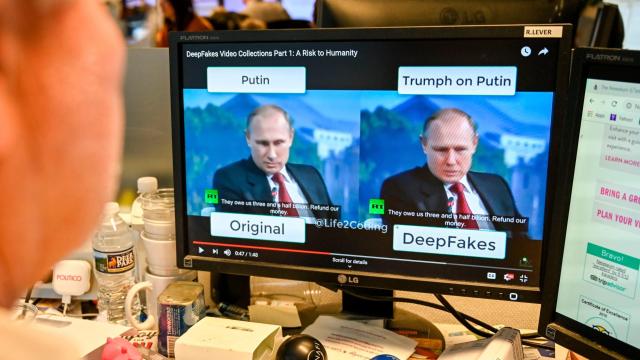Ever since we’ve seen deepfakes cropping up across porn, e-commerce, and literal bank robberies, there’s always been concern that this same tech could be used to interfere with future elections. Well, according to one new study, that might be tougher than we thought. Researchers from the Massachusetts Institute of Technology (MIT) have put out a new report investigating whether political video clips might be more persuasive than their textual counterparts, and found the answer is… not really.
“Concerns about video-based political persuasion are prevalent in both popular and academic circles, predicated on the assumption that video is more compelling than text,” the researchers wrote in their paper. This is a point we’ve heard again and again from lawmakers over the years, ever since deepfakes first popped up on their radar in mid-2019. When Sens. Rob Portman (R-OH) and Gary Peters (D-MI) introduced the Deepfake Taskforce Act this past summer, Portman noted in a statement that deepfakes posed a “unique threat” to national security.
“For most of human history seeing meant believing, but now that is becoming less and less true thanks to deepfakes,” Portman said at the time. “Combined with the network effects created by social media, fake videos or pictures can travel around the world in an instant, tricking citizens.”
To gauge how effective this tech would be at tricking anyone, the MIT team conducted two sets of studies, involving close to 7,600 participants total from around the U.S. Across both studies, these participants were split into three different groups. In some cases, the first was asked to watch a randomly selected “politically persuasive” political ad (you can see examples of what they used here), or a popular political clip on COVID-19 that was sourced from YouTube. The second group was given a transcription of those randomly selected ads and clips, and the third group was given, well, nothing at all since they were acting as the control group.
After that, each member of each group was given a questionnaire asking them to rate the “believability” of the message they saw or read — specifically, whether they believed the people in the clip actually made a particular claim. Then they were asked to rate how much they disagreed with the core point from whatever persuasive ad they were seeing.
The question these MIT researchers were trying to answer was twofold: Was seeing actually believing, the way Portman (and countless others) have said? And if it is, how much could someone’s opinion actually be swayed by video, or by text?
The result? “Overall, we find that individuals are more likely to believe an event occurred when it is presented in video versus textual form,” the study reads. In other words, the results confirmed that, yes, seeing was believing, as far as the participants were concerned. But when the researchers dug into the numbers around persuasion, the difference between the two mediums was barely noticeable, if at all.
As one of the researchers behind the project, Adam Berinsky, noted in a statement about the work, “[J]ust because video is more believable doesn’t mean that it can change people’s minds.”
Of course, this study (like all academic studies) comes with a fair share of caveats. For one, even though 7,600 people is a pretty large sample size, it might not capture the full range of opinions that every American voter might have. And as the researchers point out in their piece, the small persuasive advantage that video has over text might actually be even smaller outside of a research environment:
In both of our studies, the text-based treatments were presented in the form of a detailed transcript containing an exact replication of the audio output as well as a comprehensive description of key visual cues. In reality, politically persuasive writing may be structured quite differently (e.g., as a news article or opinion piece).
But even if that’s the case, the study notes that information presented over video has a unique advantage that text simply doesn’t: A video is more attention-grabbing and can capture more of an audience than a written report ever could.
“It’s possible that in real life things are a bit different,” David Rand, one of the other authors on the study, noted in a statement.
“It’s possible that as you’re scrolling through your newsfeed, video captures your attention more than text would,” he added. “You might be more likely to look at it. This doesn’t mean that video is inherently more persuasive than text — just that it has the potential to reach a wider audience.”
In other words: At least as far as this study is concerned, deepfake videos of a given politician aren’t likely to sway people’s political views more than a fake news report about that same politician. The only advantage that video might have is whether you believe what you’re seeing in front of you — and the number of eyeballs that clip might eventually get.
